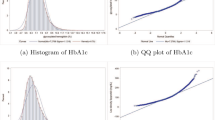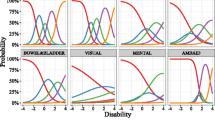Abstract
Clinical assessment scales, where subitem ratings are added and summarized as a total score, are convenient tools for monitoring disease progression and often used to measure the effect of drug treatment in clinical trials. Statistical evaluation of any beneficial treatment effects tends to focus on single-valued summary measures, for example, the difference between the score at the end of treatment and the score at baseline. Such analyses ignore potentially important features of the data, e.g. early vs. late recoveries. It is therefore of interest to develop longitudinal models that make more efficient use of the information present in non-monotonic clinical assessment scale data. We propose a two-part modeling approach for the modeling of this type of data. Non-monotonicity is managed by regarding score changes as Markovian transition events. A set of probabilistic models are used to describe the occurrences of the transitions. Continuous models are used to describe the magnitude of the scale score change, given the observed transition. In this manner, a non-monotonic disease progression is handled more efficiently than if other available methods are used. We illustrate this approach using data from a recent phase II study of a drug used in the treatment of stroke, where stroke severity was measured on the Scandinavian Stroke Scale (SSS). This scale consists of nine subitems: consciousness, eye movements, hand/arm/leg motor performance, orientation, speech, facial palsy, and gait. The data were non-monotonic, since there was at any time a risk of a score decline, despite a general tendency towards healing. The two-part probabilistic/continuous model fit the data well and proved to be robust in model-checking procedures such as posterior predictive checks and bootstrapping. The models derived using this approach could potentially accommodate drug effects, not only in terms of score improvement at end of study, but also on the onset of recovery, on dropout and on the probability of unfavorable progression patterns. In addition, it is possible to use the resulting for simulation of the prospective outcome of future studies. We conclude that this approach has considerable potential for more efficient use of information in longitudinal modeling of non-monotonic clinical assessment scale data.
Similar content being viewed by others
References
L.B. Sheiner J. Wakefield (1999) ArticleTitlePopulation modeling in drug development Stat. Methods. Med. Res. 8 183–93 Occurrence Handle10.1191/096228099672920676 Occurrence Handle10636334 Occurrence Handle1:STN:280:DC%2BD3c7gtVaruw%3D%3D
E.N. Jonsson L.B. Sheiner (2002) ArticleTitleMore efficient clinical trials through use of scientific model-based statistical tests Clin. Pharm. Ther 72 603–614 Occurrence Handle10.1067/mcp.2002.129307
P.L.S. Chan N.H.G. Holford (2001) ArticleTitleDrug treatment effects on disease progression Annu. Rev. Pharmacol. Toxicol. 41 625–659 Occurrence Handle10.1146/annurev.pharmtox.41.1.625 Occurrence Handle11264471 Occurrence Handle1:STN:280:DC%2BD3M7msF2qug%3D%3D
FDA. Guidance for Industry: E9 Statistical Principles for Clinical Trials (1998)
J.W. Mandema D.R. Stanski (1996) ArticleTitlePopulation pharmacodynamic model for ketorolac analgesia Clin. Pharm. Ther. 60 619–635 Occurrence Handle10.1016/S0009-9236(96)90210-6 Occurrence Handle1:STN:280:ByiC2c7otVI%3D
L.B. Sheiner (1994) ArticleTitleA new approach to the analysis of analgesic drug trials, illustrated with bromfenac data Clin. Pharm. Ther. 56 309–322 Occurrence Handle1:STN:280:ByqD3cflvF0%3D
D.J. Lunn J. Wakefield A. Racine-Poon (2001) ArticleTitleCumulative logit models for ordinal data: a case study involving allergic rhinitis severity scores Statist. Med. 20 2261–2285 Occurrence Handle10.1002/sim.922 Occurrence Handle1:STN:280:DC%2BD3MvitVKktA%3D%3D
M.K. Olsen J.L. Schafer (2001) ArticleTitleA two-part random-effects model for semicontinuous longitudinal data J. Am. Statist. Ass. 96 730–745
E.H. Lo T. Dalkara M.A. Moskowitz (2003) ArticleTitleMechanisms, challenges and opportunities in stroke Nat. Rev. Neurosci. 4 399–415 Occurrence Handle10.1038/nrn1106 Occurrence Handle12728267 Occurrence Handle1:CAS:528:DC%2BD3sXjtlalsbg%3D
K.R. Lees H.-C. Diener K. Asplund M. Krams (2003) ArticleTitleUK-279,276, a neutrophil inhibitory glycoprotein, in acute stroke – Tolerability and Pharmacokinetics Stroke. 34 1704–1709 Occurrence Handle12805489 Occurrence Handle1:CAS:528:DC%2BD3sXkvFyjuro%3D
InstitutionalAuthorNameScandinavian Stroke Study Group. (1985) ArticleTitleMulticenter trial of hemodilution in ischemic stroke – background and study protocol Stroke. 16 885–890
E.N. Jonsson F. McIntyre I. James M. Krams S. Marshall (2005) ArticleTitlePharmacokinetic and pharmacodynamic bridging between healthy volunteers and stroke patients for UK-276,279 using a mechanistically based model for target mediated disposition Pharm. Res. 22 1236–1246 Occurrence Handle10.1007/s11095-005-5264-x Occurrence Handle16078133 Occurrence Handle1:CAS:528:DC%2BD2MXmvFWitrg%3D
C. Hu M.E. Sale (2003) ArticleTitleA joint model for nonlinear longitudinal data with informative dropout J. Pharmacokin. Pharmacodyn. 30 83–103 Occurrence Handle10.1023/A:1023249510224
L. Lindbom J. Ribbing E.N. Jonsson (2004) ArticleTitlePerl-speaks-NONMEM (PsN) – A Perl module for NONMEM related programming Comp. Meth. Prog. Biomed 75 85–94 Occurrence Handle10.1016/j.cmpb.2003.11.003
M. Krams K.R. Lees W. Hacke A.P. Grieve J.M. Orgogozo G.AA.S. Ford (2003) ArticleTitleInvestigators. Acute stroke therapy by inhibition of neutrophils (ASTIN): an adaptive dose-response study of UK-279,276 in acute ischemic stroke Stroke. 34 2543–2548 Occurrence Handle10.1161/01.STR.0000092527.33910.89 Occurrence Handle14563972 Occurrence Handle1:CAS:528:DC%2BD3sXosFCgtro%3D
Author information
Authors and Affiliations
Corresponding author
Rights and permissions
About this article
Cite this article
Jonsson, F., Marshall, S., Krams, M. et al. A Longitudinal Model for Non-Monotonic Clinical Assessment Scale Data. J Pharmacokinet Pharmacodyn 32, 795–815 (2005). https://doi.org/10.1007/s10928-005-0098-z
Received:
Accepted:
Issue Date:
DOI: https://doi.org/10.1007/s10928-005-0098-z




